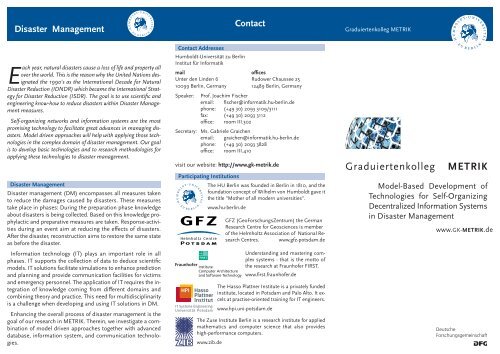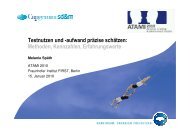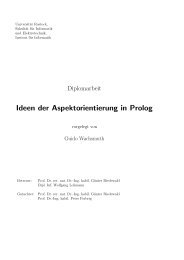Graduiertenkolleg METRIK - Humboldt-Universität zu Berlin
Graduiertenkolleg METRIK - Humboldt-Universität zu Berlin
Graduiertenkolleg METRIK - Humboldt-Universität zu Berlin
Create successful ePaper yourself
Turn your PDF publications into a flip-book with our unique Google optimized e-Paper software.
Disaster Management<br />
Contact<br />
<strong>Graduiertenkolleg</strong> <strong>METRIK</strong><br />
Each year, natural disasters cause a loss of life and property all<br />
over the world. This is the reason why the United Nations designated<br />
the 1990's as the International Decade for Natural<br />
Disaster Reduction (IDNDR) which became the International Strategy<br />
for Disaster Reduction (ISDR). The goal is to use scientific and<br />
engineering know-how to reduce disasters within Disaster Management<br />
measures.<br />
Self-organizing networks and information systems are the most<br />
promising technology to facilitate great advances in managing disasters.<br />
Model driven approaches will help with applying those technologies<br />
in the complex domain of disaster management. Our goal<br />
is to develop basic technologies and to research methodologies for<br />
applying these technologies to disaster management.<br />
Disaster Management<br />
Disaster management (DM) encompasses all measures taken<br />
to reduce the damages caused by disasters. These measures<br />
take place in phases: During the preparation phase knowledge<br />
about disasters is being collected. Based on this knowledge prophylactic<br />
and preparative measures are taken. Response-activities<br />
during an event aim at reducing the effects of disasters.<br />
After the disaster, reconstruction aims to restore the same state<br />
as before the disaster.<br />
Information technology (IT) plays an important role in all<br />
phases. IT supports the collection of data to deduce scientific<br />
models. IT solutions facilitate simulations to enhance prediction<br />
and planning and provide communication facilities for victims<br />
and emergency personnel. The application of IT requires the integration<br />
of knowledge coming from different domains and<br />
combining theory and practice. This need for multidisciplinarity<br />
is a challenge when developing and using IT solutions in DM.<br />
Enhancing the overall process of disaster management is the<br />
goal of our research in <strong>METRIK</strong>. Therein, we investigate a combination<br />
of model driven approaches together with advanced<br />
database, information system, and communication technologies.<br />
Contact Addresses<br />
<strong>Humboldt</strong>-<strong>Universität</strong> <strong>zu</strong> <strong>Berlin</strong><br />
Institut für Informatik<br />
mail<br />
offices<br />
Unter den Linden 6 Rudower Chaussee 25<br />
10099 <strong>Berlin</strong>, Germany 12489 <strong>Berlin</strong>, Germany<br />
Speaker: Prof. Joachim Fischer<br />
email: fischer@informatik.hu-berlin.de<br />
phone: (+49 30) 2093 3109/3111<br />
fax: (+49 30) 2093 3112<br />
office: room III.302<br />
Secretary: Ms. Gabriele Graichen<br />
email: graichen@informatik.hu-berlin.de<br />
phone: (+49 30) 2093 3828<br />
office: room III.410<br />
visit our website: http://www.gk-metrik.de<br />
Participating Institutions<br />
The HU <strong>Berlin</strong> was founded in <strong>Berlin</strong> in 1810, and the<br />
foundation concept of Wilhelm von <strong>Humboldt</strong> gave it<br />
the title "Mother of all modern universities".<br />
www.hu-berlin.de<br />
GFZ (GeoForschungsZentrum) the German<br />
Research Centre for Geosciences is member<br />
of the Helmholtz Association of National Research<br />
Centres. www.gfz-potsdam.de<br />
Understanding and mastering complex<br />
systems - that is the motto of<br />
the research at Fraunhofer FIRST.<br />
www.first.fraunhofer.de<br />
The Hasso Plattner Institute is a privately funded<br />
institute, located in Potsdam and Palo Alto. It excels<br />
at practise-oriented training for IT engineers.<br />
www.hpi.uni-potsdam.de<br />
The Zuse Institute <strong>Berlin</strong> is a research institute for applied<br />
mathematics and computer science that also provides<br />
high-performance computers.<br />
www.zib.de<br />
<strong>Graduiertenkolleg</strong><br />
<strong>METRIK</strong><br />
Model-Based Development of<br />
Technologies for Self-Organizing<br />
Decentralized Information Systems<br />
in Disaster Management<br />
www.GK-<strong>METRIK</strong>.de
Model-Driven Approach for<br />
Self-Organizing Information Systems in Disaster Management<br />
Self-Organizing Wireless Networks<br />
Disaster Management Cycle<br />
A disaster management system (DMS) is designed to work even<br />
after a disastrous event. Therefore it cannot rely solely on the<br />
existing public information infrastructure. Dedicated networks<br />
are needed that are either robust enough to withstand the impact<br />
of the disaster, or can be deployed rapidly after the event.<br />
Yet, these dedicated networks should inexpensive, or serve other<br />
purposes as well since the likeliness of a disaster might be<br />
small.<br />
Wireless technologies and protocols for self-organization<br />
promise to fulfill these requirements. Devices are available at<br />
reasonable cost. Wireless networks can be deployed rapidly and<br />
inexpensively. Mesh-like topologies and distributed, self-organizing<br />
protocols ensure that networks are robust against failures<br />
of individual nodes or links.<br />
<strong>METRIK</strong> investigates the use of wireless technologies for<br />
DMSs. We focus on decentralized networks and the design of<br />
protocols for self-organizing applications that use special properties<br />
of the technology. Research topics include routing, replication,<br />
effective gathering, and processing of decentralized data,<br />
dependable services, automated deployment and update of software<br />
components at runtime, and workload balancing among<br />
devices with limited resources.<br />
Self-Organizing Information Systems<br />
Self-organizing information systems (SIS) for DM face new challenges:<br />
With respect to hardware, the integration of small, embedded<br />
real-time devices, e.g. sensor networks, into the<br />
information infrastructure is necessary for a faster system response-time<br />
and higher data accuracy. From the software perspective,<br />
future SISs must provide access to heterogeneous,<br />
distributed, and rapidly changing data sources while supporting<br />
dynamically changing workflows. Considering these challenges,<br />
<strong>METRIK</strong> focuses on the following research topics:<br />
Workflow and<br />
Data Management<br />
Effective Query<br />
Processing<br />
Research Issues<br />
in the Area of<br />
Self-Organizing<br />
Information Systems<br />
Data Integration<br />
(a) We develop algorithms to efficiently gather data from wireless<br />
sensor networks (WSNs). In <strong>METRIK</strong> we use the<br />
publish/subscribe paradigm considering data-gathering as well<br />
as event-detection scenarios. We devise algorithms for efficient<br />
data retrieval based on optimized routing strategies and employ<br />
cost-based optimization of multiple queries.<br />
(b) Workflows in disaster management are information-driven;<br />
they get adapted at run-time. SISs pose new challenges for the<br />
coordination and the reliable execution of distributed transactional<br />
workflow processes. We focus on methods for modeling<br />
and verifying the correctness of dynamically adaptive workflows<br />
and on an energy efficient distribution of workflow activities to<br />
heterogeneous, resource-constrained devices. We also investigate<br />
replication strategies for enhancing data and service availability<br />
in dynamic networks.<br />
(c) To cope with heterogeneous data sources, we develop<br />
methods for semantic integration of spatiotemporal data. We<br />
focus on efficient information integration and query processing<br />
to timely provide integrated, spatially and temporally consistent<br />
data from a large number of data sources. Supplementary, we<br />
investigate methods to ensure data quality. tent data from a<br />
large number of data sources.<br />
Model-Driven Approach<br />
The development of DMSs includes the following challenges:<br />
DMSs rely on domain-specific knowledge from different fields of<br />
geosciences, government agencies, and computer sciences. A<br />
development process for DMSs must guarantee correctness<br />
and dependability of the crafted systems. On the one hand, ongoing<br />
research in WSNs and SISs suggests an integrated development<br />
spanning all technological levels to satisfy resource<br />
constraints. On the other hand, available hardware is constantly<br />
changing and different scenarios require different functionalities:<br />
there cannot be an all-purpose DMS.<br />
<strong>METRIK</strong> investiages model-driven approaches for guaranteeing<br />
flexibility, correctness, and cost reduction in the development<br />
of DMSs. Using several domain-specific languages<br />
(DSLs), experts of a domain express their approaches and solutions<br />
in terms of e.g. mathematics, workflows, and algorithms<br />
for WSNs and SISs, contributing to different aspects of a DMS.<br />
Geo<br />
Scientists<br />
Software<br />
Engineers<br />
Model-Driven<br />
Development<br />
Self-Organizing<br />
Information System<br />
Middleware,<br />
Communication<br />
Protcols<br />
Hardware for<br />
Wireless (Sensor)<br />
Networks<br />
Experts Models Transformation Implementation<br />
We develop generic metamodel-based DSL tools that allow us<br />
to define, adapt, and test the languages and models as requirements<br />
develop. These tools support the development of specific<br />
model editors, simulators and code-generators. This approach<br />
enables us to research model coupling and integration of the<br />
various modeling languages to achieve a concise representation<br />
of the entire DMS. Such an integrated model might be used to<br />
build, to verify and to validate the DMS. We research tools for a<br />
model-based development and deployment of componentbased<br />
systems to alleviate the complexity of a DMS. We investigate<br />
automatic model-based test generation to test all relevant<br />
application scenarios of the crafted system.





